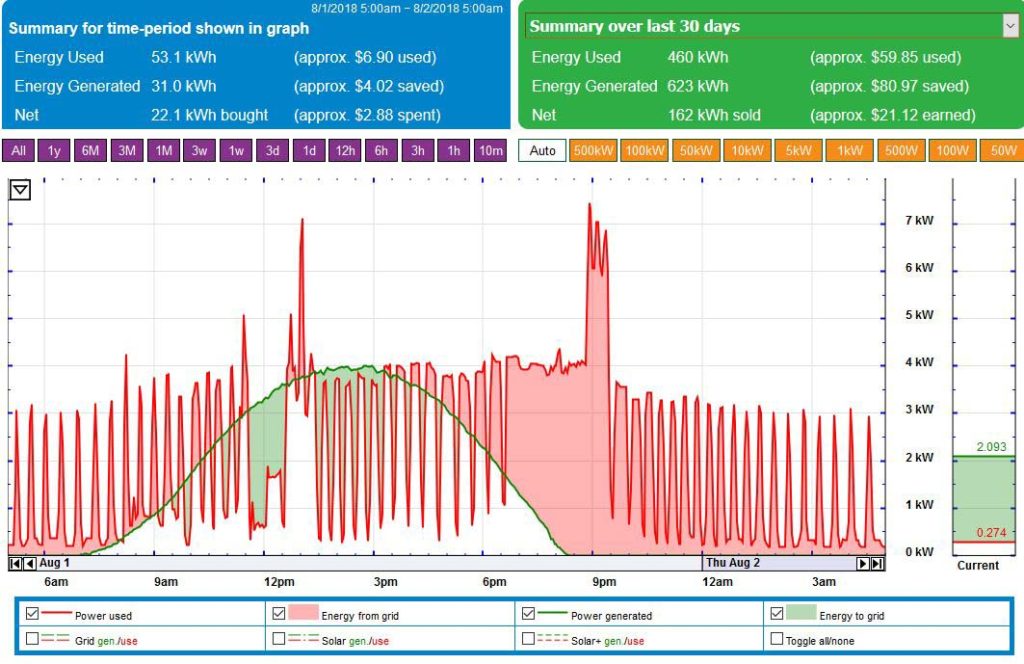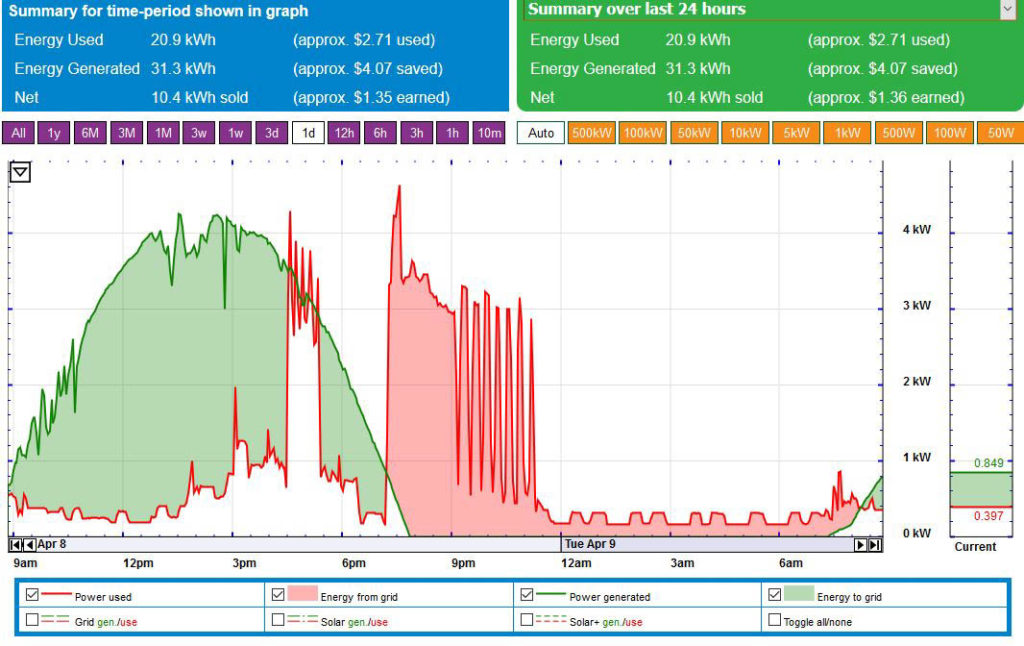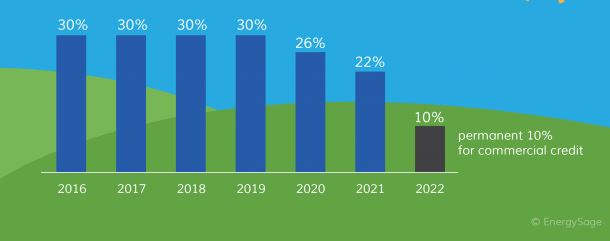
Hey. Psssst. Want to know where you can get a 15% rate of return on your money?
Rooftop solar photovoltaic systems are an amazing investment in terms of both money and environmental impact. If its been a a few years since you’ve paid attention to where the cost of solar photovoltaic (PV) energy has gone, this article will blow your mind.
If you want to nerd out on Wikipedia for a few hours and come away with a warm and fuzzy feeling about the future of energy, check out their page covering renewable energy. More specifically, take a look at the explosive growth of solar energy development.
You may have missed it, but in the last decade the cost of a megawatt of solar energy has fallen from $350 down to about $45. That statement alone is cool, but it’s way cooler when you realize that, as of 2017, natural gas was around $60, nuclear was up to $148, and coal was at $102.
Solar energy became cheaper than fossil fuel-generated energy back in 2015. Today, two-thirds of all new commercial electric production facilities being built are renewable (mostly solar an wind) rather than fossil fuel-based.
As money continues to pour into solar panel research, solar energy prices will continue to fall further below the fossil fuel competition.
Great Rate of Return on Investment
So let’s talk about the economics of putting solar panels on your roof. There are two pieces to this. The first piece is the rate of return on the panels themselves based on Austin Energy rates.
In November of 2014 I spent $10,524 on a 5.5 kW rooftop panel installation. Since I bought them, they have consistently produced about $1,000 per year worth of electricity.
That alone has given me a stable 9% rate of return on my investment.
To make the math even more interesting, I borrowed that $10,524 by refinancing equity out of my car at an interest rate at the time of about 2%. This arbitrage basically gained me a free $800 per year. Not life-changing money, but still a satisfying exercise to this investing and math enthusiast.
Good news: you have not missed the boat. Since the electric grid still relies heavily on fossil fuel-generated power, the bottom isn’t going to fall out of energy prices for many years to come. This will help ensure a decent rate of return on new panels you install this year.
Solar Panels Encourage Frugality

The second piece to solar panel economics is how they change your behavior. Prior to getting solar panels, I had little understanding of how much energy my home’s devices used or how much I could change my electric bill by throttling their usage. I figured running my air conditioner 24/7 was an inescapable cost of living in Texas.
The above graph, from August 1st of last summer, reflects the amount of energy my A/C would use if let it run all day. It’s about $5 worth of electricity in one day.
After I installed solar panels, I became far more conscious of my energy use. I went from about November 2014 through April 2015 without running my A/C and accumulated negative electric bill credits from one month to the next. It wasn’t until September 2015 that I finally used up my credits and had an $18 electric bill. I had another small electric bill in October 2015, and then didn’t have another electric bill until the summer of 2016. Each year after that has been a similar story.
Watching the monitoring software display up-to-the-second household energy usage has changed my behavior with how often I run the air conditioner or leave lights or the television on. It further encouraged me to switch from incandescent bulbs to compact fluorescent (CFL). I’m in the process of switching my CFL bulbs to LED as the CFLs burn out. CFL bulbs use about 70% less energy than incandescent, and LEDs use about 85% less than incandescent.
My energy usage now looks more like this:

The graph above is from yesterday. The tall red spikes in the middle represent air conditioner usage. I used ceiling fans during the day, cooled off my house before bedtime, then turned the A/C off for the night. The daytime baseline red along the bottom left is interior lighting, my desktop computer, a running refrigerator, and a television. The little red bumps between midnight and 6am are from my refrigerator turning on and off. The 1 kW spike in the bottom right at 8am is from using my toaster.
Since getting the panels, I’ve cut my household energy use by about half, or at least an average of $50 per month and $600 per year. Combine that $600 per year in reduced electric consumption with $1,000 in yearly energy generation and that’s a $1,600 annual reduction in household energy expense.
On a $10,524 initial investment, solar panels have given me a rate of return of 15%.
You can easily achieve the same.
You Fuel More Solar PV Development
In 2014, the panels Longhorn Solar installed for me were the 250 watt Hanwha Q-Cells Q.PRO-G3. At the time, their 15% efficiency rating was pretty good. But because so many people were willing to keep buying into solar energy and fund research and development, panels have decreased in price per watt and dramatically improved in efficiency just in the last four years alone.
Today, for same price I paid for a 250 watt panel in 2014, you can buy a 360 watt panel. That’s a 50% decrease in the cost per watt in just over 4 years, and that trend is continuing.
What’s more encouraging than manufacturing cost decreases are the continuous breakthroughs in efficiency. Commercial panels are now achieving 20+% efficiency. If that’s not cool enough, 40+% efficient panels have already been developed and will someday be as common and inexpensive as today’s 20% panels.
Panels with 90% efficiency may be on the horizon. Don’t be skeptical. 2% efficiency was a major achievement in 1955 when solar electricity cost $1,785 per watt. Today’s 20% efficiency would have been a pipe dream back then.
If 90% efficiency can be achieved, it would be a game changer for everything. Think of skyscrapers, apartment complexes, and cars with exterior surfaces that could capture that much energy from the sun. Electric vehicles could practically charge and run on their own self-generated power.
Go Solar Before Federal Tax Rebates Exire

This year, 2019, is the last year for the 30% federal solar incentive tax credit. This was a 2004 program that was only supposed to last a few years but kept getting extended due to its popularity. Next year the incentive steps down to 26%, then 22% in 2021 before going to zero for residential installations.
I’m sure the Texas Public Policy Foundation will be glad to hear that. But this completely misses the moon shot that just occurred.
The big picture is that humans, with the help of federal investment (ahem, taxpayer dollars), just pushed solar and wind technology to the point that solar and wind energy is now cheaper than the fossil fuels that powered the world for the last century and a half.
For that, we should be celebrating.
It’s a great thing that solar can finally stand on its own without tax incentives. If installing solar panels on your house interests you, take advantage of the rebates before they are gone.
